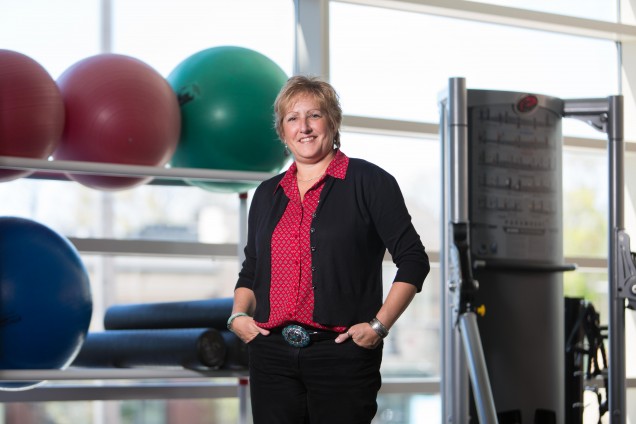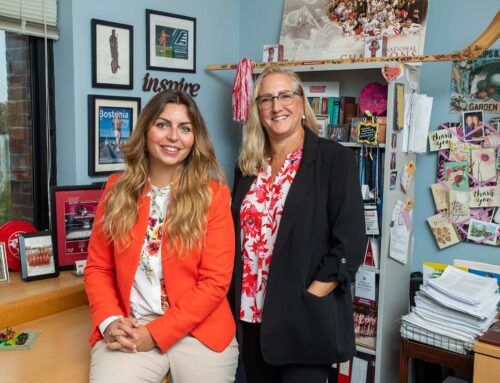Inside Sargent
October 2016
Elite long-distance runner David Proctor came to the United States ready to take on the world. At 18, the Briton had earned an exclusive athletics scholarship at Boston University—the first step to realizing his dream of Olympic glory. Within three months, his ambitions would begin to crumble, his confidence eroded by homesickness, pressure to perform, and the beginnings of a life-threatening eating disorder.
The downward spiral started with five devastating words: “You’re getting a little fat.” His coach had drummed them home with a playful pat of Proctor’s belly.
Proctor (’08) stopped eating, determined to drop from a hardly corpulent 160 pounds to a scrawny 140. He slashed his caloric intake to as low as 500 calories a day—far short of the minimum 2,500 recommended for long-distance runners. Eventually, his weight bottomed out at 130 pounds. The 5-foot-11-inch Proctor had an eating disorder.
Without adequate fuel, Proctor increased his risks of stress fractures and bone loss—during his sophomore season, he was plagued by anemia and injuries. His speed, stamina, and mental focus were slipping away, and so were his Olympic hopes.
Studies have shown that Proctor’s struggles are not uncommon. According to the NCAA, 25 percent of female and 20 percent of male college athletes suffer from disordered eating, abnormal behaviors like skipping meals or eating compulsively, which are often precursors to full-blown eating disorders such as anorexia and bulimia. (Many experts think that with so many athletes underreporting problems, the true prevalence may be much higher.) The risk factors, from genetics to competitive pressures, are also well known. Less well studied is what helps these athletes recover, says nutritionist Paula A. Quatromoni, chair of Sargent’s Department of Health Sciences.
For more than a decade, Associate Professor Quatromoni has worked to develop and refine models for treating eating disorders among college athletes. Now, she’s chronicling the path to sustained recovery through journal articles and presentations and implementing her lessons beyond BU.
Peak Performance
In February 2016, an NBC investigative unit found that administrators at California’s 21 Division I and II athletic programs were unaware of how many of their students had been treated for eating disorders and lacked plans for helping them. In the years before Proctor arrived on American soil, there was no consistent approach at BU for spotting and treating those with disordered eating: students would see athletic trainers and physicians—and sometimes get referred to off-campus sports nutritionists.
Paula Quatromoni, chair of health sciences, helped form the BU Sports Medicine Wellness Team.
That changed in 2004, when Quatromoni received a call from BU’s sports medicine director: a female runner seemed dangerously thin. Could she help? During the next few years, Quatromoni became an integral part of the lineup of sports medicine physicians and psychologists caring for athletes. Together, they formed the BU Sports Medicine Wellness Team, the core of an on-campus eating disorder treatment program. According to Quatromoni’s 2008 report on the program in the Journal of the American Dietetic Association, the team also pulled in athletic trainers, coaches, strength and conditioning coaches, and academic counselors. Formalized nutrition education programs, counseling services, and guidelines covering the journey from screening to treatment rounded out the model. Proctor and his female teammate were the first recipients of care.
Proctor had chosen to see Quatromoni, but refused her recommendation that he also see a psychologist. Eventually, he agreed to go if Quatromoni sat in on the sessions. Quatromoni says that working alongside sports psychologist Amy L. Baltzell, a clinical associate professor at BU School of Education, was life-changing for Proctor, and for Quatromoni as a professional.
“David could be very engaged in the middle of a conversation with Amy and he would put forward a very disordered belief about food that there was no way she could respond to,” she says, “but I was sitting right there, so I could jump in.”
The three met weekly for an entire summer. Proctor was given help normalizing his eating habits and addressing distorted thoughts; he added lunch to his meal routine, replaced his dorm room scale with a mini fridge, and had his body fat measured by a strength coach to reassure him that, despite the pounds of muscle he was gaining, he was still quite lean.
Proctor closed out his college career as an All-American, a track record holder, and BU’s first sub-four-minute-mile athlete.
The success of the group sessions convinced Quatromoni that a multidisciplinary model was necessary for increasing a patient’s chances of a durable recovery. Yet, more than a decade since the BU wellness team was founded, she says, “the majority of collegiate athletic departments do not employ full-time registered dietitians, leaving nutritional risk unattended to.
“In practice, there are a lot of barriers to treatment. Off-campus therapists and nutritionists are difficult for athletes to access; if a client is resistant to therapy, lack of a trusted, accessible provider becomes a barrier. My experience and reading of the literature suggests we need to break down these barriers if we truly want to help.”
In the February 2015 edition of the Annals of Sports Medicine and Research, Quatromoni and Proctor wrote about the athlete’s experiences with the program—and his subsequent recovery. Proctor has also joined Quatromoni on the speaking circuit: in 2015, the two presented at a sports science summit in the United Kingdom and, in 2016, at two conferences for sports dietitians in the United States. Quatromoni says there is a growing number of dietitians working with athletes, but few are sharing their success stories—it means her papers and presentations are serving a largely unmet need.
And, she adds, the chance to add Proctor’s voice to the literature is a rare one: He’s male and willing to talk. Quatromoni believes his case also helps highlight gender biases in patterns of screening, recognition, referral, and treatment of eating disorders.
As an undernourished freshman, Proctor was never mandated to see Quatromoni, nor was he placed on a contract outlining recovery goals. He self-referred to her because he thought she could help him lose more weight. By contrast, the female athlete Quatromoni saw at the same time received a mandated referral from BU Athletics and was sidelined from running with a therapeutic contract—she was banned from training and competition until she met certain recovery targets. BU’s revamped program aims to equalize referrals across genders, but Quatromoni says systems elsewhere and societal attitudes may still work against male athletes and undermine early intervention.
Competitive athletics “is a very macho environment—you’re not allowed to show weakness in any way; that’s just how it is when you’re part of an elite-level sport,” says Proctor.
Another reason Quatromoni is keen to share Proctor’s story is that he was treated (using BU resources) for five years. “Most people don’t stay in treatment that long,” she says. “Insurance doesn’t pay for that.” Quatromoni says that limitations in health insurance coverage for eating disorder treatment are a common barrier to care. She adds that Proctor’s long-term sporting success is important to share, too. Today, Proctor is still an elite runner and competed in the 2016 British Olympic trials.
“Not everybody recovers from eating disorders,” says Quatromoni. “There’s a very high mortality rate, the highest of any psychological disorder.” Studies have shown that anorexia has a 46 percent recovery rate—and a 6 percent death rate.
In its first two years of full operation, BU’s Sports Medicine Wellness Team gave nutrition advice to 68 student-athletes from 19 teams; 46 percent of those served showed signs of disordered eating and were treated by members of the wellness team. Many of those students would have gone untreated in the past. In 2009, the Sargent Choice Nutrition Center took over the provision of nutrition services to athletes, incorporating them into its suite of programs for the wider BU community.
It Takes an Army
Quatromoni hopes her successes in referring and treating athletes serve as a call to action, and not just within college sports. Since 2015, she’s worked as a senior consultant to Walden Behavioral Care, a Boston-area eating disorder treatment group. She helped it launch Walden GOALS, an intensive outpatient treatment program that shares the approach of the BU effort: nutritionists and mental health professionals working as a team to address the specific needs and vulnerabilities of athletes of all ages. Quatromoni knows of only one other similar private initiative in the United States—the Victory Program at McCallum Place in St. Louis, Missouri.
The Walden partnership also opens new practicum positions for Sargent dietetics students and research opportunities for Quatromoni. She’s keen to delve into the clinic’s 16 years’ worth of patient data, particularly on the understudied male population. In a separate project, Quatromoni is surveying members of the International Federation of Eating Disorder Dietitians to examine the quality and availability of training opportunities for nutritionists working in eating disorder treatment settings.
Every so often, Quatromoni still gets a call from the athletes who helped her pilot BU’s care model, including Andrea Walkonen (’08, SED’10), the runner whose eating disorder sparked that first call from the sports medicine director. As an undergraduate, Walkonen was diagnosed with a common trifecta among female athletes: disordered eating, over-exercising, and amenorrhea, or loss of menstrual periods.
“It takes an army to deal with this sort of thing,” says Walkonen, who, like Proctor, recovered, becoming an All-American and competing in the 2016 US Olympic trials. “It’s not something that will go away, but I’m at the point where I’ve learned to overcome negative thoughts and continue to progress.”







